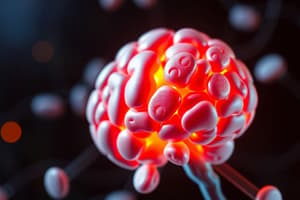Podcast
Questions and Answers
What is a possible side effect associated with using bromides in animals?
What is a possible side effect associated with using bromides in animals?
- Hepatitis
- Hyperthermia
- Ataxia (correct)
- Hypersensitivity
Which anticonvulsant drug is a glutamate blocker, and given by mouth?
Which anticonvulsant drug is a glutamate blocker, and given by mouth?
- Primidone
- Zonisamide
- Gabapentin (correct)
- Phenobarbital
Which drug is a good alternative to phenobarbital, and has three active metabolites?
Which drug is a good alternative to phenobarbital, and has three active metabolites?
- Primidone (correct)
- Gabapentin
- Potassium bromide
- Zonisamide
What is a potential disadvantage of using primidone?
What is a potential disadvantage of using primidone?
Which anticonvulsant is often used in conjunction with phenobarbital or Kbr?
Which anticonvulsant is often used in conjunction with phenobarbital or Kbr?
What is a potential side effect associated with using potassium bromide in animals?
What is a potential side effect associated with using potassium bromide in animals?
Which anticonvulsant drug is a sulfonamide, and acts as a NA/CA channel blocker?
Which anticonvulsant drug is a sulfonamide, and acts as a NA/CA channel blocker?
Which anticonvulsant is a good alternative to phenobarbital, and has three active metabolites?
Which anticonvulsant is a good alternative to phenobarbital, and has three active metabolites?
Which of the following are disadvantages of using primidone as an anticonvulsant? (Select all that apply)
Which of the following are disadvantages of using primidone as an anticonvulsant? (Select all that apply)
Which of these is NOT a characteristic of bromides as an anticonvulsant?
Which of these is NOT a characteristic of bromides as an anticonvulsant?
Flashcards
Anticonvulsants
Anticonvulsants
Medications used to prevent seizures by stabilizing neuronal activity.
Bromide toxicity
Bromide toxicity
Adverse effects from bromides, including blindness, coma, and ataxia.
Potassium bromide administration
Potassium bromide administration
Typically compounded and must be given with food while monitoring serum levels.
Primidone
Primidone
Signup and view all the flashcards
Zonisamide
Zonisamide
Signup and view all the flashcards
MOA of Bromides
MOA of Bromides
Signup and view all the flashcards
Bromide side effects
Bromide side effects
Signup and view all the flashcards
Potassium bromide monitoring
Potassium bromide monitoring
Signup and view all the flashcards
Gabapentin action
Gabapentin action
Signup and view all the flashcards
Primidone metabolites
Primidone metabolites
Signup and view all the flashcards
Study Notes
Anticonvulsants: Bromides
- Mechanism of Action (MOA): Uncertain, decreases neuronal discharge and interferes with chloride transport. Sodium and potassium bromide are involved.
- Pharmacokinetics: Long half-life.
- Toxicity: Blindness, coma, dysphoria, stupor, ataxia, and paresis.
- Potassium Bromide: Typically compounded and taken with food. Serum levels must be monitored. Can be used with phenobarbital.
- Disadvantages: Respiratory dysfunction, nausea, vomiting, polyuria, polyphagia, sedation, and ataxia. Narrow therapeutic index.
Anticonvulsants: Dopamine, Phenobarbital, Primidone
- Phenobarbital: An alternative/option when other medications are not well-tolerated. Has multiple metabolites that produce an effect.
- Primidone: Another option with 3 metabolites, which results in an effect.
- Disadvantage: Hepatotoxicity (liver damage) and hepatic necrosis (cell death). Potentially no advantage over phenobarbital; good option if phenobarbital is not well-tolerated.
- Comparison: No clear advantage to using only primidone.
Anticonvulsants: Gabapentin
- Mechanism of Action (MOA): Alpha 2 delta ligands.
Anticonvulsants: Gamma Amino Acid Derivatives
- Glutamate blockers: Given orally. Reduce the release of excitatory neurotransmitter Glutamate, aiding with neuropathic pain and potentially used with phenobarbital or potassium bromide. May induce sedation.
Anticonvulsants: Zonisamide
- Mechanism of Action (MOA): Sodium and calcium channel blocker. Given by mouth (oral).
- Advantages: Alternative for animals reactive to phenobarbital and also can be used in conjunction with it. Minimal side effects. Wide therapeutic margin.
- Disadvantages: Limited understanding of full effects, expensive, and short half-life.
Studying That Suits You
Use AI to generate personalized quizzes and flashcards to suit your learning preferences.




